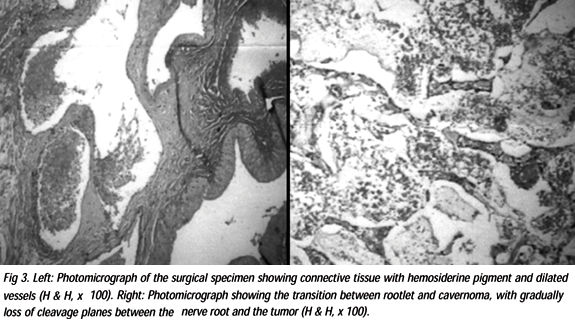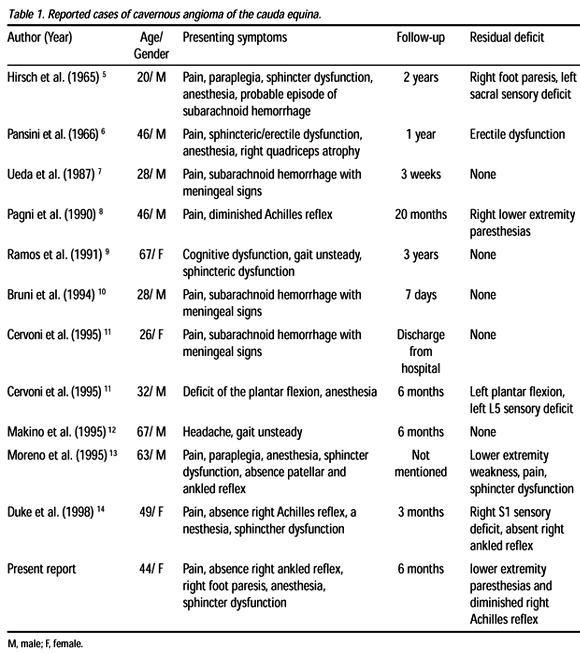Abstracts
We present a rare case of cavernous angioma of the cauda equina and review the eleven cases available in the literature. A 44-year-old woman presented with low back pain and sciatica associated with bowel and bladder dysfunction and motor weakness of the lower extremity. The MRI revealed an enhancing, heterogeneous and hyperintense intradural lesion compressing the cauda equina roots at the L4 level. Laminectomy at L3-L4 and total removal of the tumor were performed without additional neurological deficit. Pathology revealed a cavernous angioma. The literature, clinical presentation, technical examinations, and treatment are reviewed.
cavernous angioma; cauda equina; cavernoma
Relatamos um caso de angioma cavernoso de cauda equina em mulher de 44 anos de idade com sintomas de lombociatalgia associada a fraqueza de membros inferiores e disfunção esfincteriana vesical e anal. Exame de ressonância magnética evidenciou lesão expansiva intradural heterogênea e hiperintensa na cauda eqüina. Indicado tratamento cirúrgico com remoção completa através de laminectomia L3 e L4. O exame anatomopatológico foi compatível com angioma cavernoso. Os onze casos encontrados na literatura são revisados correlacionando a apresentação clínica, tratamento proposto e prognóstico.
angioma cavernoso; cauda eqüina; cavernoma
Cavernous angioma of the cauda equina: case report
Angioma cavernoso de cauda equina: relato de caso
Asdrubal FalavignaI; Orlando Righesso NetoII; José Augusto Nasser dos SantosIII; Fernando Antonio Patriani FerrazIV
IDepartment of Neurosurgery of Caxias do Sul University, Caxias do Sul RS, Brazil
IIDepartment of Orthopaedic Surgery of Caxias do Sul University, Caxias do Sul RS, Brazil
IIIPost-Graduation in Neurosurgery, Escola Paulista de Medicina - Federal University of São Paulo, São Paulo SP, Brazil (EPM-UNIFESP)
IVChairman of Department of Neurosurgery of EPM-UNIFESP
ABSTRACT
We present a rare case of cavernous angioma of the cauda equina and review the eleven cases available in the literature. A 44-year-old woman presented with low back pain and sciatica associated with bowel and bladder dysfunction and motor weakness of the lower extremity. The MRI revealed an enhancing, heterogeneous and hyperintense intradural lesion compressing the cauda equina roots at the L4 level. Laminectomy at L3-L4 and total removal of the tumor were performed without additional neurological deficit. Pathology revealed a cavernous angioma. The literature, clinical presentation, technical examinations, and treatment are reviewed.
Key words: cavernous angioma, cauda equina, cavernoma.
RESUMO
Relatamos um caso de angioma cavernoso de cauda equina em mulher de 44 anos de idade com sintomas de lombociatalgia associada a fraqueza de membros inferiores e disfunção esfincteriana vesical e anal. Exame de ressonância magnética evidenciou lesão expansiva intradural heterogênea e hiperintensa na cauda eqüina. Indicado tratamento cirúrgico com remoção completa através de laminectomia L3 e L4. O exame anatomopatológico foi compatível com angioma cavernoso. Os onze casos encontrados na literatura são revisados correlacionando a apresentação clínica, tratamento proposto e prognóstico.
Palavras-chave: angioma cavernoso, cauda eqüina, cavernoma.
Cavernous angioma is a vascular malformation created by anomalous vessels without interposition of neural tissue1. Primary tumors of the filum terminale and conus medullaris, or both, comprise only 6% of spinal cord tumors2. Only 6.2% to 7.5% of all intraspinal tumors are vascular3,4. The cavernous angioma rarely occurs in the cauda equina. The literature reports eleven cases5-14.
We report on a woman with a cavernous angioma of the cauda equina presenting with low back pain with sciatica, motor and sensory deficit of the lower extremities and bladder and bowel sphincter dysfunction.
CASE
A 44-year-old woman presented with a 4-month history of low back pain and bilateral sciatica. The pain was exacerbated by ambulation. The pain became worse in the last 10 days and was associated with lower extremity numbness, difficulty in walking and bladder and bowel control sphincter loss. The neurologic examination demonstrated bilateral loss of pin prick at L4, L5 and S1 dermatomes, right absence of Achilles reflex, bilateral positive straight leg raising test and a paresis during the examination of plantar flexion and dorsiflexion of the right foot. The urinary postvoid residual was 200-mL. Magnetic resonance imaging (MRI) of the lumbar spine showed a 30 mm x 20 mm heterogeneous enhancing and high signal intensity mass completely obliterating the spinal canal at the L4 level (Fig 1). High-dose steroids was started and surgery was indicated.
After a laminectomy at L3 and L4 the dura was tense and without pulsation. The dura and arachnoid were opened under microscopic magnification. A 3-cm dark-bluish tumor was seen, displacing the caudal nerve roots circumferentially around it. After separation from the arachnoid membranes, the tumor still adhered closely to a thin root that could not be dissected free at the tumor center because it disappeared inside the capsule (Fig 2 and Fig 3).
After cutting the root, the neoplasm was totally removed. Histopathological examination revealed many narrow vessels and large dilated vascular channels totally or partly obstructed by thrombi. The diagnosis was cavernous angioma (Fig 3). The postoperative course was uneventful, and the patient was discharged after 6 days without pain, the bladder and bowel function returned to normal, absence of the right Achilles reflex, lower extremity paresthesias and the motor strength of the right foot was almost normal. At the 6-month follow-up neurologic examination, no residual motor deficit of the right foot, lower extremity paresthesias and diminished right ankled reflexes were observed. In fomed, free and written consent was signed by the patient for the publication her case.
DISCUSSION
Cavernous angioma represents 5 to 16% of spinal vascular anomalies preferably located at the vertebral bodies15. Cavernous angioma occurring whiting the cauda equina are even more rare, with only eleven cases reported in the literature5-14. Sometimes the cavernous angioma can be located at the lumbar epidural space16.
In these cases, eight of the eleven patients were male and three female, presenting between the ages of 20 and 67 years, 42.9 years being the average (Table 1). The clinical symptoms were related to subarachnoid hemorrhage (headache, nuchal rigidity and vomiting) in three cases7,10,11, local compression of adjacent nerve roots (low back pain and sciatica, sensitive and motor disturbance of the lower limbs, sphincter dysfunction) in six5,6,8,11-14, and, in two cases, symptoms of intracranial hypertension caused by hydrocephalus9,12. The symptoms usually had acute onset in the subarachnoid hemorrhage patients, in the hydrocephalus patients the symptoms started four and three months before admission, and when the symptoms were related with expansive process, the average of beginning of symptoms ranged between ten days and nine years. In all previously reported cases, as in ours, the tumor was totally removed despite their close adherence to the nerve roots.
In the case described by Pagni et al. 8, and our case, the tumor was excised with the attached thin nerve root because the root merging into the tumor made it impossible to individualize despite microsurgical dissection. This was seen in the histological sections of the nerve root and tumor interface (Fig 3). Nevertheless, resection of this thin nerve root that becomes part of the tumor stroma did not compromise good recovery, probably because it was nonfunctional. In all cases, as in ours, there were gradual clinical improvements after lesion resection. In the cases presented with hydrocephalus there was an improvement of the ventriculomegaly without shunt six months12 and three years9 after tumor removal. These show that complete resection can be achieved safely using careful microsurgical technique. Residual deficit observed in the reported cases at the last follow-up was sexual impotence, foot paresis, diminished Achilles reflex and lower extremity sensory loss5,6,8,11-14.
In conclusion, cavernous angiomas of the cauda equina are extremely rare lesions that may present as low back pain with sciatica, neurologic deficit, or as subarachnoid hemorrhage. They can be successfully treated by surgery.
Received 15 September 2003, received in final form 16 December 2003. Accepted 16 January 2004.
Dr. Asdrubal Falavigna - Rua Coronel Camisão 241/301 - 95020-420 Caxias do Sul RS - Brasil. E-mail: asdrubal@doctor.com
- 1. Simard J, Garcia-Bengochea F, Ballinger W, Mickle J, Quisling R. Cavernous angioma: a review of 126 collected and 12 new cases. Neurosurgery 1986;18:162-172.
- 2. Norstrom C, Kernohan J, Love J. One hundred primary caudal tumors. JAMA 1961;178:1071-1077.
- 3. Rasmussen T, Kernohan J, Adson A. Pathologic classification, with surgical consideration, of intraspinal tumors. Ann Surg 1940;111:513-530.
- 4. Costa LB Jr, Andrade A, Braga BP, Ribeiro CA. Cauda equina hemangioblastoma: case report. Arq Neuropsiquiatr 2003;61:456-458.
- 5. Hirsch J, Pradat P, David M. Angiome caverneux de la queue de cheval. Neurochirurgie 1965;11:323-327.
- 6. Pansini A, Lo Re F. Raro case di angiocavernoma della cauda. Men Soc Tos Um Chir 1966;27:679-696.
- 7. Ueda S, Saito A, Inomori S. Cavernous angioma of the cauda equina producing subarachnoid hemorrhage. J Neurosurg 1987;66:134-136.
- 8. Pagni A, Canavero S, Forni M. Report of a cavernoma of the cauda equina and review of the literature. Surg Neurol 1990;33:124-131.
- 9. Ramos FJ, De Toffol B, Aesch B, Jan M. Hydrocephalus and cavernoma of the cauda equina. Neurosurgery 1990;27:139-142.
- 10. Bruni P, Massari A, Greco R, Hernandez R, Oddi G, Chiappetta F. Subarachnoid hemorrage from cavernous angioma of the cauda equina: case report. Surg Neurol 1994;41:226-229.
- 11. Cervoni L, Celli P, Gagliardi F. Cavernous angioma of the cauda equina: report of two cases and review of the literature. Neurosurg Rev 1995;18:281-283.
- 12. Makino K, Takamura H, Gotoh S, Andoh M. Cauda equina cavernous hemangioma associated with hydrocephalus: case report. No To Shinkei 1995;47:783-787.
- 13. Moreno R, Romero J, Serrano V, Madrid A, Jarrín S, Casado J. Cavernoma intradural extramedular de cola de caballo. Rev Neurol 1995;23:1228-1230.
- 14.. Duke B, Levy A, Lillehei K. Cavernous angiomas of the cauda equina: case report and review of the literature. Surg Neurol 1998;50:442-445.
- 15. Newton TM, Potts D. Computed tomography of the spine and spinal cord. In. Vascular malformations. San Anselmo, CA:Clavadel Press, 1983:398.
- 16. Félix A, Koerbel A, Hanel RA, Cichon E, Araújo JC. Angioma cavernoso espinhal epidural: relato de caso. Arq Neuropsiquiatr 2001;59:440-443.
Publication Dates
-
Publication in this collection
20 July 2004 -
Date of issue
June 2004
History
-
Accepted
16 Jan 2004 -
Reviewed
16 Dec 2003 -
Received
15 Sept 2003





